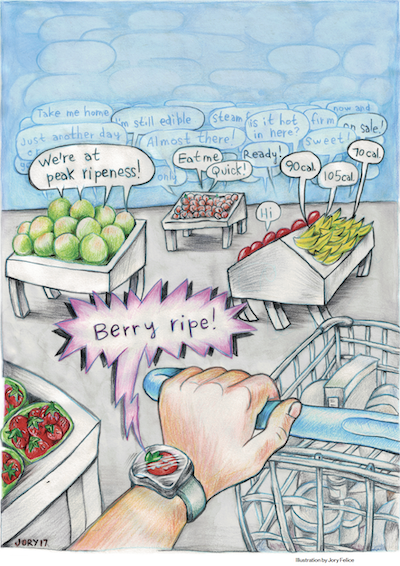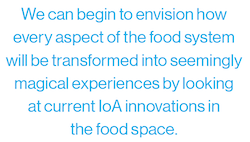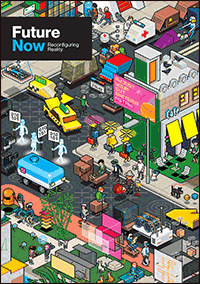Future Now
The IFTF Blog
Billions and Billions Transacted
How the Internet of Actions will transform everything to do with food
 In 1994 a journalist named Josh Quittner registered the domain name mcdonalds.com. On assignment for Wired, Quittner called McDonald’s corporate headquarters to find out if they cared. He asked a McDonald’s media relations representative if anyone there could talk to him about McDonald’s Internet plans. She did some digging and told him later, “I don’t have anything for you, and I probably won’t have anything for you. I’ve left a lot of voicemail for people, but no one seems to know anything about it.” So Quittner did what any reasonable person in possession of the domain would do—he set up ronald@mcdonalds.com as his email address.
In 1994 a journalist named Josh Quittner registered the domain name mcdonalds.com. On assignment for Wired, Quittner called McDonald’s corporate headquarters to find out if they cared. He asked a McDonald’s media relations representative if anyone there could talk to him about McDonald’s Internet plans. She did some digging and told him later, “I don’t have anything for you, and I probably won’t have anything for you. I’ve left a lot of voicemail for people, but no one seems to know anything about it.” So Quittner did what any reasonable person in possession of the domain would do—he set up ronald@mcdonalds.com as his email address.
McDonald’s eventually wised up and got the domain from Quittner. Today, server farms are as important to McDonald’s as potato farms. The hamburger giant has greatly benefitted from Internet-based communications—every aspect of its operations is dependent on high-speed data processing, from commodity market analysis to social media marketing. And over the next decade, the physical components of McDonalds—trucks, shipping containers, grills, employee uniforms—will become embedded with millions of intelligent sensors, processors, and effectors that communicate with each other and act on behalf of other machines, people, and organizations. McDonalds, along with every entity that adds value through coordination, will use Internet-connected objects and environments to produce well-orchestrated experiences powered by the Internet of Actions (IoA).
Why Food is Ripe for the Internet of Actions
The experience of food is an ever-changing sensorium of taste, smell, texture, and community. It’s the experience of the farmer and soil scientist working together to cultivate a crop. It’s the overworked volunteer team preparing 5,000 meals a day in a camp for climate refugees. It’s the chef working with the biohacker to invent new proteins and the food retailer working with the virtual reality (VR) game designer to reimagine how to shop for groceries. All of the areas can be greatly enhanced with IoA technology.
For decades, meeting the needs of busy people scrambling to fit food into their lives has driven innovation for new food experiences. But we are facing even greater challenges today. The political stability of democracies is under threat. The climate is becoming increasingly volatile. Automation is on the rise, and conventional daily rhythms are being disrupted for many reasons. It’s clear that 21st century food experiences will happen in very different contexts from the way we experience them today. We’ll need to adapt to these changes by creating new eating and drinking occasions, new pathways and biozones for sourcing our food, and new strategies for ensuring safe, sovereign food in turbulent times.
Automation will be a major driver that rewrites the story and the context of convenient food access. Over the next decade, robots and algorithms will transform the way we access food on the go. Already, robots are cooking and assembling fast-food burgers, allowing for on-demand customization without sacrificing speed and efficiency. Automation is turning grocery stores into super-sized vending machines and food carts into self-delivering food services. As platform apps connect people to these services, technologies will get smarter, and experiences will become more streamlined and customized.
In the midst of any eating experience, the story of the place: the utensils, the lighting, the music, and the overall ambiance will all be related and integrated in unprecedented ways. Current marketing and food experience design already leverage aspects of context like color and lighting that point in this direction. But in an IoA, where objects are animated and connected, new opportunities will arise to incorporate context into food experiences.
Signals of Change
We can begin to envision how every aspect of the food system will be transformed into seemingly magical experiences by looking at current IoA innovations in the food space.
Food with a nose
- C2Sense has developed an “artificial nose” sensor that detects ethylene, a gas naturally released as produce ripens. An increase in ethylene signals an acceleration of ripeness. (If you’ve ever been told to stick an avocado in a paper bag to help it ripen, that is a DIY attempt to trap ethylene.)
- Smart fruit labels with C2Sense will enable grocery stores to sell fruits and vegetables at their peak and allow customers to scan produce via a smartphone app to ensure they purchase food with their desired level of ripeness. In the next decade, sensors that monitor ripeness of food will be embedded into packaging, storage units, and grocery store shelves and will sense not just ripeness, but will monitor a plethora of factors, like micro and macronutrient levels, accurate caloric content, and microbial diversity.
- Your grocery shopping experience will become highly customized to your preferences. Your smart watch will get an alert that the strawberries you love are at the ripeness level you prefer and are available at the bodega around the corner. Just click the berry icon and they will be held for you, or delivered wherever you happen to be at the moment.
- Your smart cookbook’s built-in nose will sniff the ripeness of your groceries and adjust the cooking time and methods to maximize flavor.
Pricetags that fluctuate by the second
- Ripeness sensors are just one way to provide real-time information about a food product. New real-time data collection and analysis tools will proliferate over the next decade, which will lead to the electronic and dynamic pricing label. On shelves, boxes, or food products themselves, electronic labels enable stores to dynamically change prices and promotions across every shelf, in every store, everywhere. Prices may increase as fruit reaches peak ripeness, or decrease as bananas get soft or the clock ticks closer to closing time for the store. These electronic labels can contain information about total stock availability, reviews from social media platforms, and geo-located promotions targeted at specific shopping carts.
- Over the next 10 years, electronic labels will be connected to more and more smart objects in the store, radically transforming the context of walking down a grocery aisle. Cameras will see what you have in your shopping cart, and predictive algorithms will anticipate what you’re looking to buy, adjusting prices for specific products accordingly. Financial information about your purchasing history will be leveraged to adjust pricing based on what you’ve been willing to spend in the past, or even on the price of the clothes or jewelry you’re wearing.
- The implications extend beyond the walls of the grocery store. Dynamic pricing can help provide greater purchasing insight to the local baker who needs to understand when and how much to bake, or to the local farmer trying to maximize profits by only harvesting when the market is right.
 Meal kits with a chef-in-the-box
Meal kits with a chef-in-the-box
- Sensor and pricing technologies will be part of every meal kit delivered to your doorstep.
- In 2017, Amazon filed a trademark patent for a meal-delivery service with the motto: “We do the prep. You be the chef.” With a targeted acquisition of Whole Foods and their unparalleled logistics of delivery, it’s clear that Amazon has plans to disrupt the meal-delivery space.
- In the constant quest to differentiate, meal delivery services will be enabled by the IoA to turn home cooking into a new context for learning. Meal kit boxes will be embedded with AI to not only deliver the food, but also deliver customized cooking advice (like adjusting recipes with an awareness that you don’t buy anything containing sweeteners) and instructions while you’re in your home.
- Paired with your smart kitchen, the delivery box will monitor your technique and provide real-time cooking feedback so that you will never burn your rice again. Different boxes will tap into the cult of personality behind different chefs, just like the emerging AI assistants today have different tones and intonations. After the meal, the chef-in-a-box will monitor your success and adjust future meals to ensure you’re constantly challenged to master new cooking techniques.
Farm as data centers
- The Leafy Green Machine is a vertical, hydroponic freight farming system built inside a shipping container that is capable of growing your typical hearty greens, lettuces, and herbs. The Leafy Green Machine already is filled from floor to ceiling with sensors and AI to ensure maximum yield. The IoA will enable freight farms to communicate with each other, creating a distributed network of agricultural data centers that can learn from one another, diversify the types of crops grown to fulfill the changing demand of their consumer base, and tighten the food supply chain.
Neighborhood Food
- Falling Fruit is a global urban harvest map that unites foragers, freegans, and urban eaters by collecting data about over a half million free food sources, including trees, plants, fungi, and even dumpsters containing available food for public harvest.
- In an Internet of Actions, trees and dumpsters will transmit information about fallen fruit or discarded food to adjacent smartphones, local chefs, or even your smart kitchen (that knows you need a lemon for dinner tonight). The context around food procurement resources and culture will be crowdsourced and the ingredient supply chain will be hyper-localized.
 FUTURE NOW—Reconfiguring Reality
FUTURE NOW—Reconfiguring Reality
This third volume of Future Now, IFTF's print magazine powered by our Future 50 Partnership, is a maker's guide to the Internet of Actions. Use this issue with its companion map and card game to anticipate possibilities, create opportunities, ward off challenges, and begin acting to reconfigure reality today.
About IFTF's Future 50 Partnership
Every successful strategy begins with an insight about the future and every organization needs the capacity to anticipate the future. The Future 50 is a side-by-side relationship with Institute for the Future: a partnership focused on strategic foresight on a ten-year time horizon. With 50 years of futures research in society, technology, health, the economy, and the environment, we have the perspectives, signals, and tools to make sense of the emerging future.
For More Information
For more information on IFTF's Future 50 Partnership and Tech Futures Lab, contact:
Sean Ness | sness@iftf.org | 650.233.9517



